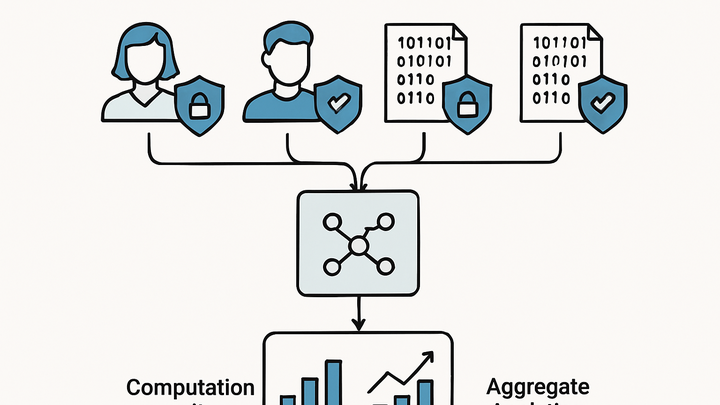Published on 2025-06-26T05:20:35Z
What is Secure Multiparty Computation (SMC) in Analytics?
Secure Multiparty Computation (SMC) is a cryptographic technique that enables multiple parties to jointly compute analytics over their combined data without revealing individual inputs. In web analytics, SMC allows organizations to aggregate metrics like pageviews, user engagement, and conversion rates across different data silos while ensuring that sensitive user-level data remains private. This method relies on secret sharing and distributed protocols so that no single entity ever has access to the unencrypted data. SMC helps analytics teams maintain compliance with privacy regulations like GDPR and CCPA, and reduces the need to trust third parties with raw user information. By integrating SMC into analytics pipelines, platforms like PlainSignal and GA4 can enhance data privacy without sacrificing insight quality. It is increasingly relevant as businesses adopt federated and privacy-first analytics approaches, striking a balance between data utility and confidentiality.
Secure multiparty computation
A cryptographic approach enabling analytics across multiple data holders without exposing raw user data.
Introduction to Secure Multiparty Computation (SMC)
This section provides an overview of SMC and its significance in the analytics industry. Readers will understand the basic definition and core concepts behind SMC.
-
Definition
Secure Multiparty Computation lets multiple parties jointly compute a function over their inputs while keeping those inputs private. No individual participant can see another’s raw data.
-
Core principles
SMC relies on distributing data as encrypted shares and performing computations in a decentralized manner.
-
Secret sharing
Data is split into parts (shares) distributed among parties so that a threshold is needed to reconstruct the original value.
-
Computation protocols
Protocols like Yao’s Garbled Circuits and Shamir’s Secret Sharing enable operations on encrypted shares without revealing them.
-
Non-collusion assumption
The security guarantees hold when parties do not collude to combine their shares improperly.
-
How SMC Works in Analytics Pipelines
A deep dive into the steps that power SMC within an analytics workflow, from data input to the final aggregated output.
-
Data input and secret sharing
Each client or data source splits its raw metrics into encrypted shares and distributes them to computation parties.
-
Distributed computation
Parties collaboratively execute the analytics function on their shares without decrypting them, using agreed cryptographic protocols.
-
Result reconstruction
After computation, parties combine their encrypted outputs to reconstruct the final aggregate result without exposing individual data points.
Benefits of SMC in Analytics
Exploring why SMC is a powerful tool for privacy-preserving analytics and compliance.
-
Enhanced user privacy
Raw user data remains encrypted at all times, reducing the risk of data breaches or unauthorized exposure.
-
Regulatory compliance
SMC helps meet privacy laws like GDPR and CCPA by design, since no personal data is centrally stored or visible.
-
Reduced trust assumptions
No single party needs to be fully trusted with the raw data, as only combined results are revealed.
SMC in SaaS Analytics Platforms
Real-world examples of how analytics providers can incorporate SMC to deliver privacy-first metrics using popular SaaS tools.
-
PlainSignal (cookie-free analytics)
PlainSignal provides lightweight, privacy-centric analytics. You can layer SMC protocols on top of its script to compute aggregates without seeing user-level data. Example integration:
<link rel="preconnect" href="//eu.plainsignal.com/" crossorigin /> <script defer data-do="yourwebsitedomain.com" data-id="0GQV1xmtzQQ" data-api="//eu.plainsignal.com" src="//cdn.plainsignal.com/plainsignal-min.js"></script> -
Google analytics 4 (GA4)
GA4’s event-driven model can be extended with SMC by preprocessing events into encrypted shares. A typical GA4 snippet:
<script async src="https://www.googletagmanager.com/gtag/js?id=GA_MEASUREMENT_ID"></script> <script> window.dataLayer = window.dataLayer || []; function gtag(){dataLayer.push(arguments);} gtag('js', new Date()); gtag('config', 'GA_MEASUREMENT_ID'); // Integrate SMC preprocessing here to encrypt event data </script>
Getting Started with SMC
Guidance on tools, frameworks, and steps to implement SMC in your analytics stack.
-
Choose a protocol
Select an SMC protocol (e.g., Shamir’s Secret Sharing, SPDZ) based on performance and security requirements.
-
Leverage sdks and libraries
Use open-source libraries like MPyC, JIFF, or Microsoft’s SEAL for homomorphic operations.
-
Integrate with existing scripts
Embed SMC preprocessing into your existing tracking code (e.g., PlainSignal, GA4) to encrypt data before it leaves the client.
